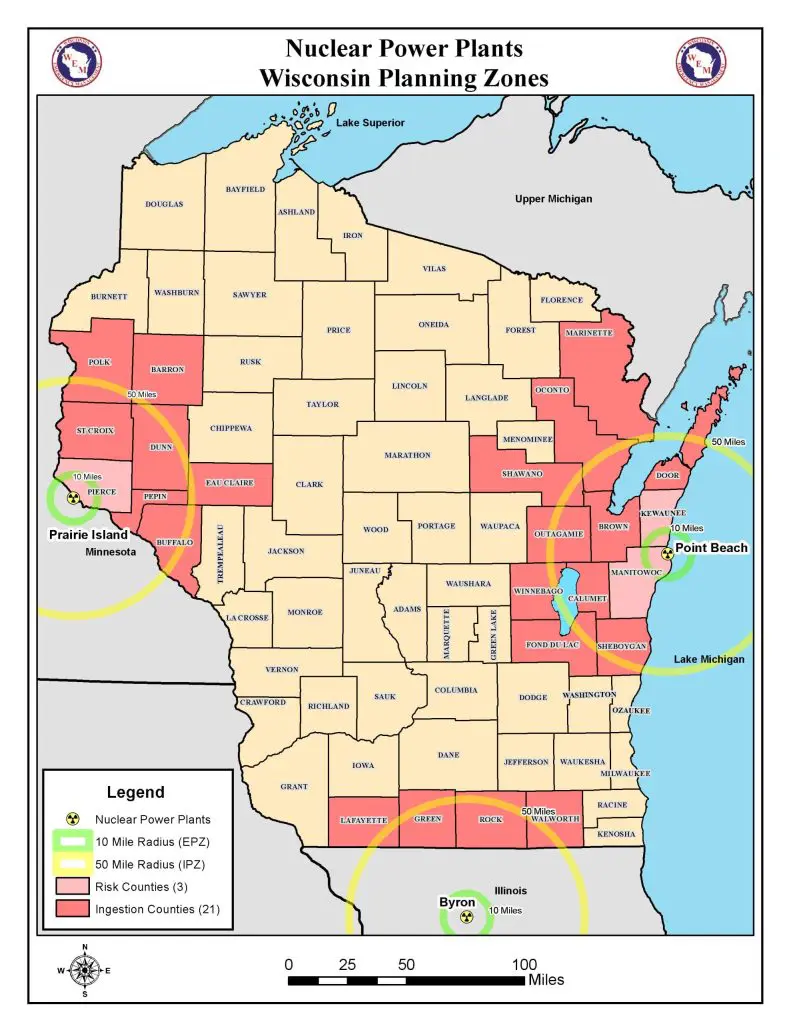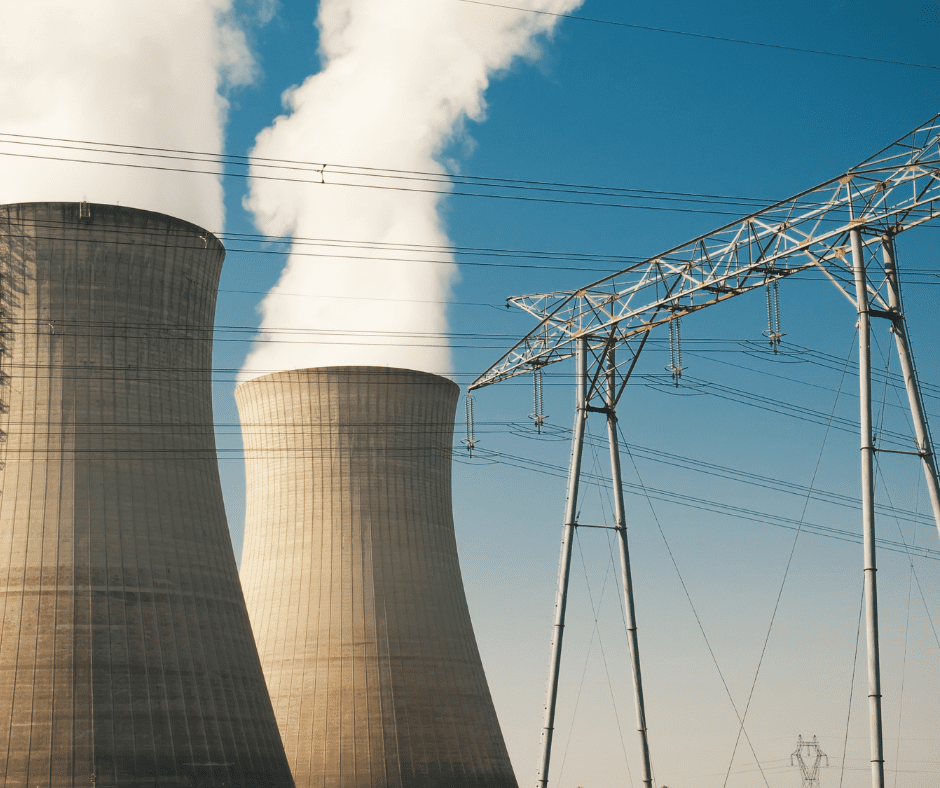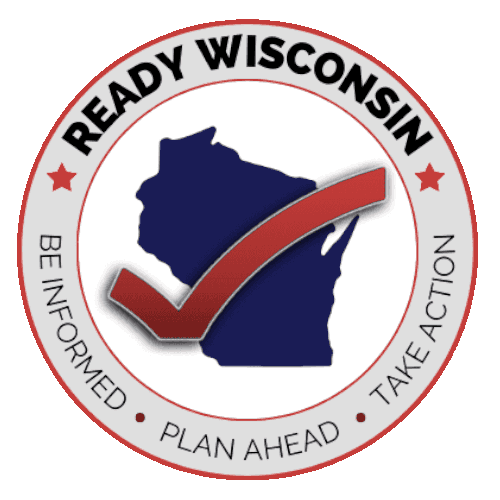Nuclear power plants use the heat generated from nuclear fission in a contained environment to convert water to steam, which powers generators to produce electricity. Although the construction and operation of these facilities are closely monitored and regulated by the Nuclear Regulatory Commission (NRC), accidents are possible.
Wisconsin Emergency Management develops, plans, and conducts exercises to respond to the potential release of materials from three nuclear power plants that are within or near the state’s borders.
Wisconsin has one operating nuclear power plant, Point Beach Nuclear Plant located in Two Rivers. Two other nuclear plants that could affect areas of our state include Prairie Island Nuclear Generating Plant located in Welch, Minnesota and the Byron Nuclear Generating Station in Byron, Illinois.

Four Emergency Classification Levels During a Power Plant Emergency
Notification of Unusual Event
This is the lowest classification and means that a minor plant event has occurred. No radiation leak is expected and no action on your part is necessary. This level ensures the first steps for future response are being carried out, operations staff are at the ready, and the plant is handling unusual events information and decision-making.
Alert
This is declared when there is a decrease in the level of plant safety or there is a security event that can threaten site personnel or damage plant equipment. Any release of radioactive material that could occur is expected to be minimal and below limits established by the U.S. Environmental Protection Agency guides. This level makes sure emergency personnel are ready and available to respond if the situation becomes more serious and allows offsite authorities to receive current information on plant status.
Site Area Emergency
Events are in progress or have occurred which have caused or will likely cause major plant failures that impact safety measures designed to protect the public, or involve security events with intentional damage that could lead to the likely failure of equipment to protect the public. This level ensures emergency response centers are staffed, monitoring teams are dispatched, personnel required for evacuating nearby areas are at duty stations, proper communication with offsite authorities, and government authorities are providing the public with updates.
General Emergency
This is the most serious of emergency classification levels. Events are in progress that have caused substantial reactor core damage with the potential for uncontrolled releases of radioactive materials, or security events that deny plant staff physical control of the facility. This declaration initiates predetermined protective actions for the public including: continuous dose monitoring, additional protective measures as necessitated by potential or actual releases, consultation with offsite authorities, and updates to the public by government authorities.
Protecting Yourself…
…Before a Radiological Emergency
- Have a standard emergency supply kit with the addition of plastic sheeting, duct tape, and scissors.
- Make a family emergency plan
- Sign up for emergency updates, if available, from your county emergency management agency to receive timely and specific information in your area.
- Review local emergency response plans for nuclear power plant emergencies and store it where you can easily retrieve it if needed. These plans are tested through exercises that include protective actions for the general public and special populations. These plans also discuss evacuation routes, reception centers for radiological monitoring and care centers for temporary lodging.
- Residents within 10 miles of a nuclear plant receive emergency information materials annually. This information is commonly distributed via phone books, calendars, brochures, utility bills, postcards and other forms. These materials contain educational information on radiation, instructions for evacuation and sheltering, special arrangements for the handicapped, and contacts for additional information.
- For yourself or members of your household that will need assistance during an evacuation, please register each year with Kewaunee County (920-845-9701), Manitowoc County (920-683-4207), or Pierce County (715-273-6751)
…During a Radiological Emergency
If a nuclear power plant emergency occurs near you, stay calm and listen to local television or radio stations for updates and instructions from state and local officials.
- Minimize Exposure. Increase the distance between you and the source of radiation. This could mean sheltering in place or evacuation.
- If advised to stay indoors: This is often referred to as sheltering in place. Radioactive material settles on the outside of buildings.
- Go to the middle or basement of your home, away from doors and windows. Below ground basements provide the best option.
- Bring pets inside.
- Close and lock all windows and doors.
- If possible, turn off fans, air conditioners, and forced-air heating united that bring air in from the outside.
- Close fireplace dampers.
- Seal gaps in doors and windows with wet towels, plastic, wax paper, aluminum wrap, or duct tape.
- Don’t leave your shelter or evacuate unless told to do so.
- Post a “NOTIFIED” sign for authorities.
- During sheltering, prepare items for possible evacuation of you, your family and/or your pets.
- Don’t leave your shelter or evacuate unless told to do so.
- If you have loved ones in schools, daycares, hospitals, nursing homes, or other places, STAY WHERE YOU ARE. They will be instructed to stay inside and have emergency plans in place to keep people safe at their facility.
- If you are in a vehicle:
- Get inside a building right away.
- Carefully remove your outer clothing layers carefully before entering the building if you can. Once inside, wash the parts of your body that were uncovered when you were outside. Then put on clean clothing, if you can.
- Once inside, go to the basement or middle of the building.
- Eat food in sealed containers. Unspoiled food in your refrigerator or freezer is also safe to eat. Do not pick or eat food from your garden until emergency officials deem it is safe to do so.
- Drink bottled water. Scientists will test drinking water sources to make sure they are safe.
- If advised to evacuate. Follow the designated routes to reach the the nearest reception center where evacuees are monitored for radiological contamination. Be ready for the possibility you may not be able to return home for an extended period of time.
- Stay calm, don’t panic
- Prepare home as if leaving on vacation.
- Don’t forget to bring your pets
- Assist neighbors as needed, if possible
- Keep vehicle windows and vents closed
- What to bring with you for an evacuation:
- Personal identification
- Prescription medications
- Baby formula and diapers
- Cash, checkbook, and credit cards
- Clothing for a week per person
- Portable radio, flashlight, and extra batteries
- Phone, electronic charges, cables
- First aid kit
- Personal hygiene items
- Bedding (sleeping bags and pillows)
- Pet carriers, supplies, and food
- Wet wipes and/or towels
- School children will be cared for through the school’s emergency procedures. Do not attempt to pick up students from their schools unless advised to do so
…After a Radiological Emergency
- Stay tuned to local radio or television for the latest emergency information
- Follow decontamination instructions from local authorities
- Seek medical treatment for unusual symptoms, such as nausea or skin burns, as soon as possible.
- Return home only when authorities say it is safe
- Keep food in covered containers or in the refrigerator.

Additional Resources
- Point Beach Nuclear Plant Safety Information
- Prairie Island Nuclear Power Plant Information and Emergency Planning Guide
- Byron Generating Station Safety Information
- CDC Decontamination Guides
- Wisconsin Emergency Management Radiological Emergency Preparedness
- Radiological Emergency Information for Farmers, Food Processors, and Distributors
- CDC Radiation Emergency Guides
- Radiological Dispersion Device Safety
